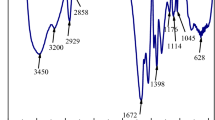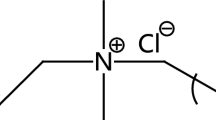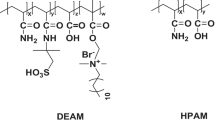Abstract
In this study, a salt-resistant hydrophobic association polymer (PZDY) was synthesized from acrylamide, octadecyl dimethylallyl ammonium chloride, and decane polyoxyethylene ether acrylate by aqueous polymerization. Infrared spectroscopy, fluorescence spectroscopy, scanning electron microscopy, and other characterization methods were used to study its properties and the rheological properties of the PZDY solution were analyzed. The results showed that when concentration of NaCl is less than 5 wt% and that of CaCl2 is less than 1 wt%, the viscosity of 0.4 wt% PZDY increased with an increase of the salt concentration. When the salt concentration continued to increase, the PZDY viscosity gradually decreased. Investigation of the rheological behaviors showed that the 0.6 wt% PZDY in the 5 wt% NaCl and 1 wt% CaCl2 solution could withstand temperatures up to 180 °C after being sheared for 2500 s at 170 s−1 and its viscosity exceeded 50 mPa·s. Moreover, the viscosity of the 0.6 wt% PZDY in 5 wt% NaCl increased from 104 to 205 mPa·s and that in 1 wt% CaCl2 increased from 110 to 157 mPa·s at a shear rate of 170 s–1, at 180 °C, and a shear time of less than 500 s. Meanwhile, scanning electron microscope (SEM) results showed that the salt addition enhanced the quasi-spatial network structure, with closer clustering of PZDY molecules in the NaCl solution than in the CaCl2 solution. The storage modulus (G′) and loss modulus (G″) increased with the increase of the PZDY concentration. Therefore, PZDY can be used to improve the heat and shear resistance of fracturing fluids and enhance oil recovery.













Similar content being viewed by others
Availability of data and materials
All of the material is owned by the authors and no permissions are required.
References
Shi JM, Wu ZL, Deng QC, Liu L, Zhang XF (2022) Synthesis of hydrophobically associating polymer: temperature resistance and salt tolerance properties. Polym Bulln 79:4581–4591
Liang X, Zhou F, Liang T (2020) Impacts of low harm fracturing fluid on fossil hydrogen energy production in tight reservoirs. Int J Hydrogen Energy 45(41):21195–21204
Zhao SH, Sun YH, Wang HR (2019) Modeling and field-testing of fracturing fluid back-flow after acid fracturing in unconventional reservoirs. J Petrol Sci Eng 176(8):494–501
Li DX, Wang YH, Sun Y (2021) Evaluation and research on the influence of fracturing fluid on reservoir damage in typical block of Songbei tight oil. Oil Prod Eng 1(21–25):78–79
Duan ZY (2010) Research progress on weighted fracturing fluid technology for deep well with high pressure. Fault-Block Oil Gas Field 17(4):500–502
Wu SY, Xia PH, Li YB (2017) Preparation and performance analysis of hydrophobic associating polymer for oil displacement. Contemp Chem Ind 46(5):821–823
Pan Y, Xia C, Yang SC (2019) Research progress on high temperature water-based fracturing fluid. Chem Ind Eng Prog 38(8):1913–1920
Chen TF, Chen F, Cheng XL(2019). Development and application of natural polymer vegetable gum flocculant. Oil-field Chem 36(4):610–614, 635
Cun M, Mao JC, Sun HL (2021) Development of a novel temperature-resistant and salt-resistant double-cationic surfactant with “super thick hydration layer” for clean fracturing fluid. Coll Surfaces A Physicochem Eng Aspects 617:126306–126319
Kang W, Mushi SJ, Yang H (2020) Development of smart viscoelastic surfactants and its applications in fracturing fluid: a review. J Petrol Sci Eng 190:107107–107156
Tian JZ, Mao JC, Zhang WL (2021) Salinity- and heat-tolerant VES (Viscoelastic Surfactant) clean fracturing fluids strengthened by a hydrophobic copolymer with extremely low damage. ChemistrySelect 6(9):2126–2143
Wang J, Wang SL, Lin W (2017) Formula optimization and rheology study of clean fracturing fluid. J Mol Liq 241:563–569
Cao HB, Ye AC, You L (2020) YLS-03 Type clean fracturing fluid performance research. Paper Making Equip Mater 49(2):31–32
Sun YD, Li J, Yu SH (2021) Preparation and application of a multifunctional emulsion polymer as fracturing fluid. Petrochem Technol 50(4):325–331
Lu DL, Chen Y, Zhang J (2018) Synthesis and properties of modified polymer fracturing fluid. Appl Chem 35(11):1295–1300
Gao JH, Zhang GH, Wang L (2019) Rheological properties of an ultra-high salt hydrophobic associated polymer as a fracturing fluid system. RSC Adv 9(27):15246–15256
Pu WF, Jiang F, Wei B (2017) A gel-like comb micro-block hydrophobic associating polymer: synthesis, solution property and the sol-gel Transition at semi-dilute Region. Macromol Res 25(2):151–157
Yue XA, Jing Y, Zheng Y (2005) Research on two critical concentrations behavior of a hydrophobic associating copolymer. Chemistry 10:793–796
Yu J, Gou SH, Li Q (2020) A graft-modification of chitosan with twin-tail hydrophobic association polymer for enhance oil recovery. Chem Phys Lett 763:138164–138189
Zheng CC, Huang ZY (2018) Self-assembly and regulation of hydrophobic associating polyacrylamide with excellent solubility prepared by aqueous two-phase polymerization- ScienceDirect. Coll Surfaces A Physicochem Eng Aspects 555:621–629
Liu M, Gou S, Wu Q, Yang X, He Y, Zhou L (2019) Ionic liquids as an effective additive for improving the solubility and rheological properties of hydrophobic associating polymers. J Mol Liq 296
Song J, Fan WN, Long XL, Zhou L, Wang C, Li GH (2016) Rheological behaviors of fluorinated hydrophobically associating cationic guar gum fracturing gel. J Petrol Sci Eng 146:999–1005
Pu WF, Du DJ, Liu R (2018) Preparation and evaluation of supramolecular fracturing fluid of hydrophobically associative polymer and viscoelastic surfactant. J Petrol Sci Eng 167:568–576
Tian HY, Quan HP, Huang ZY (2020) Investigation on rheological properties and thickening mechanism of a novel thickener based on hydrophobically associating water-soluble polymer during the acid rock reaction. J Petrol Sci Eng 188
Mao JC, Tan HZ, Yang B (2018) Novel hydrophobic associating polymer with good salt tolerance. Polymers 10(8):849–868
Quan HP, Tian HY, Huang ZY (2017) Salt stimulus response of a carboxyl betaine amphoteric hydrophobic associative polyacrylamide. Russ J Appl Chem 90:1193–1201
Mao JC, Xue JX, Zhang H, Yang XJ, Lin C, Wang QH, Li C, Liao ZJ (2022) Investigation of a hydrophobically associating polymer’s temperature and salt resistance for fracturing fluid thickener. Coll Polym Sci 300(5):569–582
Shi JM, Wu ZL, Deng QC, Liu L, Zhang XF, Wu KY, Wang YG (2022) Synthesis of hydrophobically associating polymer: temperature resistance and salt tolerance properties. Polym Bull 79(7):4581–4591
Ma XP, Mu HL, Hu YY, Yang SW (2021) Synthesis and properties of hydrophobically associating polymer fracturing fluid. Coll Surface A 626:127013–127025
Yamamoto H, Tomatsu I, Hashidzume A, Morishima Y (2000) Associative properties in water of copolymers of sodium 2-(acrylamido)-2-methylpropanesulfonate and methacrylamides substituted with alkyl groups of varying lengths. Macromolecules 33(21):7852–7861
Zhang Y, Zhou ZP, Chen MS (2018) The length of hydrophobic chain in amphiphilic polypeptides regulates the efficiency of gene delivery. Polymers 10(4):379–393
Mao JC, Tan HZ, Yang B, Zhang WL, Yang XJ, Zhang Y, Zhang H (2018) Novel hydrophobic associating polymer with good salt tolerance. Polymers 10(8):849–867
Wang C, Li XR, Li PZ, Niu YH, Yang XW (2013) Preparation and self-assembly properties of silicone-modified hydrophobically associating polyacrylamide. J Polym Res 20(147):1–9
Geng TM (2011) Synthesis and properties of hydrophobically associating water-soluble polymers P(AM/NaAA/DiACl2). Appl Chem Ind 40(9):1599–1602
Pu WF, Du DJ, Liu R, Li KW, Huang TW (2016) Synthesis and evaluation of β-cyclodextrin-functionalized hydrophobically associating polyacrylamide. RSC Adv 6(98):96006–96014
Zhang Y, Mao JC, Zhao JZ, Yang XJ, Xu T, Lin C, Mao JH, Tan HZ, Zhang ZY, Yang B, Ma SY (2019) Preparation of a hydrophobic-associating polymer with ultra-high salt resistance using synergistic effect. Polymers 11(4):626–643
Meiling Fan ML, Wang L, Li J, He P, Lai XJ, Gao JH, Liu GR, Wen X (2022) Preparation of supramolecular viscoelastic polymers with shear, temperature, and salt resistance/sensitivity by amphiphilic functional monomer modification. Polym Test 116:107799–107810
Gao JH, Zhang GH, Zhao YH (2019) Synthesis and rheological properties of a salt-resistant hydrophobic association polymer. Fine Chem 36(9):1936–1942
Funding
This research was supported by the Service Program for Foreign Experts of Shaanxi Province of China (2022WGZJ-27), Key R & D Program of Shaanxi Province (2023-YBGY-307), Industrialization Project of Shaanxi Provincial Education Department (21JC005), and Science and Technology Program of Xi’an (22GXFW0014).
Author information
Authors and Affiliations
Contributions
Xiaojuan Lai: conceptualization, funding acquisition, writing—review and editing; Guiru Liu: conceptualization, methodology, software, investigation, formal analysis, writing—original draft, writing—review and editing; Yong Liu: visualization, investigation; Xinping Dong: resources, supervision; Xiaoqing Liu: resources, supervision; Yasir Mukhtar: resources, supervision; Lei Wang: investigation, formal analysis; Xin Wen: formal analysis, supervision; Lijuan Lu: resources, supervision.
Corresponding author
Ethics declarations
Ethical approval
This declaration is not applicable. Our research does not need to use humans or animals as research objects.
Competing interests
The authors declare no competing interests.
Additional information
Publisher's Note
Springer Nature remains neutral with regard to jurisdictional claims in published maps and institutional affiliations.
Rights and permissions
Springer Nature or its licensor (e.g. a society or other partner) holds exclusive rights to this article under a publishing agreement with the author(s) or other rightsholder(s); author self-archiving of the accepted manuscript version of this article is solely governed by the terms of such publishing agreement and applicable law.
About this article
Cite this article
Lai, X., Liu, G., Liu, Y. et al. Preparation and viscoelasticity of novel hydrophobic associating polymer with salt stimulation responsiveness by functional monomer modification for fracturing fluids. Colloid Polym Sci 301, 1271–1283 (2023). https://doi.org/10.1007/s00396-023-05150-w
Received:
Revised:
Accepted:
Published:
Issue Date:
DOI: https://doi.org/10.1007/s00396-023-05150-w




